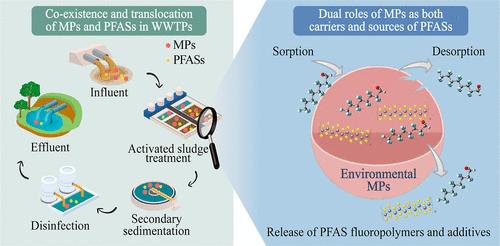揭示污水处理厂中微塑料与全氟烷基和多氟烷基物质(PFASs)相互作用的真相:微塑料作为全氟烷基物质的载体及其他
IF 11.3
1区 环境科学与生态学
Q1 ENGINEERING, ENVIRONMENTAL
引用次数: 0
摘要
微塑料(MPs)和全氟烷基和多氟烷基物质(PFASs)是环境中普遍存在的污染物,但它们的共存和相互作用仍未得到充分了解。在这项研究中,我们通过全面的采样和分析工作,证实了多磺酸钠和全氟磺酸钠同时存在于污水处理厂(WWTP)中,并确定了它们不同的分布模式。显著相关性(p <;特定类型MPs与PFASs之间存在0.05),提示它们有共同的来源。此外,MPs被鉴定为PFAS的载体,PFAS浓度在122 ~ 166 ng/g之间,主要由全氟辛酸(PFOA)和全氟丁酸(PFBA)组成。实验室验证实验表明,全氟辛烷磺酸(PFOS)、全氟辛烷磺酸(PFOA)和全氟辛烷磺酸(PFBA)的总浓度最高可达10.4 ng/mL,在水溶液环境中可从MPs中浸出全氟辛烷磺酸,其中商用MPs具有较高的浸出潜力。在吸附/解吸实验中,全氟辛烷磺酸的解吸效率超过120%,证实了其从MPs本身释放。这些结果突出了MPs作为PFASs的载体和来源的双重作用。在污水处理厂不同基质中确定的污染物概况和MPs和PFASs之间的相关性提供了有价值的见解,并为进一步研究有效减轻其环境污染的主动措施奠定了基础。本文章由计算机程序翻译,如有差异,请以英文原文为准。

Unveiling the Truth of Interactions between Microplastics and Per- and Polyfluoroalkyl Substances (PFASs) in Wastewater Treatment Plants: Microplastics as a Carrier of PFASs and Beyond
Microplastics (MPs) and per- and polyfluoroalkyl substances (PFASs) are ubiquitous contaminants in environments, yet their co-occurrence and interactions remain insufficiently understood. In this study, we confirmed the concurrent presence of MPs and PFASs and their distinct distribution patterns in a wastewater treatment plant (WWTP) through a comprehensive sampling and analysis effort. Significant correlations (p < 0.05) were observed between specific types of MPs and PFASs, suggesting their shared sources. Moreover, MPs were identified as carriers of PFASs, with PFAS concentration ranging between 122 and 166 ng/g, predominantly consisting of perfluorooctanoic acid (PFOA) and perfluorobutanoic acid (PFBA). The laboratory verification experiment revealed that PFASs could be leached from MPs in aqueous environments, in which commercial MPs exhibited higher leaching potential, with the highest combined concentration of perfluorooctanesulfonate (PFOS), PFOA, and PFBA reaching 10.4 ng/mL. PFOS demonstrated a desorption efficiency exceeding 120% in sorption/desorption experiments, confirming its release from the MPs themselves. These results highlighted the dual roles of MPs as both carriers and sources of PFASs. The identified contaminant profiles and correlations between MPs and PFASs across different matrices in WWTP provide valuable insights and form a basis for further research into proactive measures to effectively mitigate their environmental contamination.
求助全文
通过发布文献求助,成功后即可免费获取论文全文。
去求助
来源期刊

环境科学与技术
环境科学-工程:环境
CiteScore
17.50
自引率
9.60%
发文量
12359
审稿时长
2.8 months
期刊介绍:
Environmental Science & Technology (ES&T) is a co-sponsored academic and technical magazine by the Hubei Provincial Environmental Protection Bureau and the Hubei Provincial Academy of Environmental Sciences.
Environmental Science & Technology (ES&T) holds the status of Chinese core journals, scientific papers source journals of China, Chinese Science Citation Database source journals, and Chinese Academic Journal Comprehensive Evaluation Database source journals. This publication focuses on the academic field of environmental protection, featuring articles related to environmental protection and technical advancements.
 求助内容:
求助内容: 应助结果提醒方式:
应助结果提醒方式:


